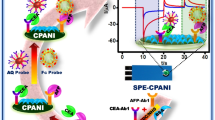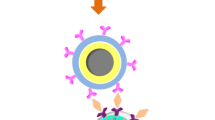Abstract
In this paper, a simple and feasible immunoassay protocol with signal amplification for sensitive determination of alpha fetoprotein (AFP, used as a model) by using new enzyme-induced Fenton reaction (EIFR) accompanying the oxidation of o-phenylenediamine (OPD) system. We discovered that glucose oxidase (GOx) has the ability to stimulate in situ Fenton reaction coupling the oxidation of OPD. GOx-catalyze of glucose results in the formation of hydrogen peroxide (H2O2). It can catalytically oxidize Fe2+to Fe3+, meanwhile producing hydroxyl radicals (•OH). The latter effectively initiated the catalytic oxidation of o-phenylenediamine (OPD) to 2,2-aminoazobenzene (DAP), resulting in the production of an electrochemical signal. On the basis of EIFR-OPD system, a new immunoassay protocol with GOx/anti-pAb2-conjugated gold nanoparticle (Ab2-AuNP-GOx) detection antibody can be designed for the detection of target AFP on capture antibody–functionalized transparent 96-well polystyrene microplate, monitored by recording the current peak of the generated DAP. The electrochemical current shows to be positively correlated with the concentration of target AFP. Under optimal conditions, the proposed assay exhibited good electrochemical responses for detecting target AFP in the range of 1.0 pg mL−1 to 100 ng mL−1 with a detection limit (LOD) of 0.5 pg mL−1 (0.5 ppt) estimated at the 3Sblank level. Additionally, the precision, reproducibility, specificity, and method accuracy were also investigated with acceptable results. Importantly, the EIFR-OPD system can be further extended for the determination of other protein or biomarkers by controlling the specific recognition system (antibody or aptamer).






Similar content being viewed by others
References
Yi H, Heng Z (2017) Protein array-based approaches for biomarker discovery in cancer. Genom Proteom Bioinf 15:73–81
Xue J, Yang L, Wang H, Yan T, Fan D, Feng R, Du B, Wei Q, Ju H (2019) Quench-type electrochemiluminescence immunosensor for detection of amyloid β-protein based on resonance energy transfer from luminol@SnS2-Pd to Cu doped WO3 nanoparticles. Biosens Bioelectron 133:192–198
Zhang J, Jin R, Jiang D, Chen H (2019) Electrochemiluminescence-based capacitance microscopy for label-free imaging of antigens on the cellular plasma membrane. J Am Chem Soc 141(26):10294–10299
Fernandes E, Cabral P, Campos R, Machado G, CerqueiraM SC, Freitas P, Borme J, Petrovykh D, Alpuim P (2019) Functionalization of single-layer graphene for immunoassay. Appl Surf Sci 480:709–716
Kwak J, Lee S (2019) Highly sensitive piezoelectric immunosensors employing signal amplification with gold nanoparticles. Nanotechnology. https://doi.org/10.1088/1361-6528/ab36c9
Lin Y, Zhou Q, Lin Y, Tang D, Chen G, Tang D (2015) Simple and sensitive detection of aflatoxin B1 within five minute using a non-conventional competitive immunosensing mode. Biosens Bioelectron 74:680–686
Zhou J, Tang J, Chen G, Tang D (2014) Layer-by-layer multienzyme assembly for highly sensitive electrochemical immunoassay based on tyramine signal amplification strategy. Biosens Bioelectron 54:323–328
Wei T, Ren P, Huang L, Ouyang Z, Wang Z, Kong X, Li T, Yin Y, Wu Y, He Q (2019) Simultaneous detection of aflatoxin B1, ochratoxin A, zearalenone and deosynivalenol in corn and wheat using surface plasmon resonance. Food Chem 300:125176–125182
Takemura K, Lee J, Suzuki T, Hara T, Abe F, Park E (2019) Ultrasensitive detection of norovirus using a magnetofluoroimmunoassay based on synergic properties of gold/magnetic nanoparticle hybrid nanocomposites and quantum dots. Sensor Actuat B-Chem 296:126672–126679
Wang Y, Li D, Ren W, Liu Z, Dong S, Wang E (2008) Ultrasensitive colorimetric detection of protein by aptamer-Au nanoparticles conjugates based on a dot-blot assay. Chem Commun 2008:2520–2522
Zhang Y, Tan W, Zhang L, Shi S, Niu Y, Yang X, Qiao J, Wang H (2019) Highly sensitive and selective colorimetric determination of staphylococcus aureus via chicken anti-protein A lgY antibody. Anal Methods 11:3665–3670
Lin Z, Lv S, Zhang K, Tang D (2017) Optical transformation of a CdTe quantum dot-based paper sensor for a visual fluorescence immunoassay induced by dissolved silver ions. J Nater Chem B 5:826–833
Chen Y, He Q, Shen D, Jiang Z, Eremin S, Zhao S (2019) Fluorescence polarization immunoassay based on a new monoclonal antibody for the detection of the diisobutyl phthalate in yoghurt. Food Control 105:38–44
Liu B, Zhang B, Chen G, Tang D (2014) An omega-like DNA nanostructure utilized for small molecule introduction to stimulate formation of DNAzyme-aptamer conjugates. Chem Commun 50:1900–1902
Zeng K, Wei D, Zhang Z, Meng H, Huang Z, Zhang X (2019) Enhanced competitive immunomagnetic beads assay with gold nanoparticles and carbon nanotube-assisted multiple enzyme probes. Sensor Actuat B-Chem 292:196–202
Xiang H, Wang Y, Wang M, Shao Y, Jiao Y, Zhu Y (2018) A redoc cycling-amplified electrochemical immunosensor for α-fetoprotein sensitive detection via polydopamine nanolabels. Nanoscale 10:13572–13580
Wang X, Hu X, Xiao F, Dai J, Zeng X, Ye L, Liu B (2019) A convenient signal amplification strategy for the carcinoembryonic antigen determination based on the self-polymerization of dopamine. J Solid State Electrochem 23:2447–2453
Huang L, Zhang L, Yang L, Yuan R, Yuan Y (2018) Manganese porphyrin decorated on DNA networks as quencher and mimicking enzyme for construction of ultrasensitive photoelectrochemistry aptasensor. Biosens Bioelectron 104:21–26
Zhao Z, Pang J, Liu W, Lin T, Ye F, Zhao S (2019) A bifunctional metal organic framework of type Fe (III)-BTC for cascade (enzymatic and enzyme-mimicking) colorimetric determination of glucose. Microchim Acta 186:295–302
Xu L, Liu Z, Lei S, Huang D, Zou L, Ye B (2019) A sandwich-type electrochemical aptasensor for the carcinoembryonic antigen via biocatalytic precipitation amplification and by using gold nanoparticle composites. Microchim Acta 186:473–481
Yang Z, Zhuo Y, Yuan R, Chai Y (2015) An amplified electrochemical immunosensor based on in situ-produced 1-naphthol as electroactive substance and graphene oxide and Pt nanoparticles functionalized CeO2 nanocomposites as signal enhancer. Biosens Bioelectron 69:321–327
Zhang H, Choi H, Huang C (2005) Optimization of Fenton process for the treatment of landfill leachate. J Hazard Mater 125:166–174
Boulange M, Lorgeoux C, Biache C, Saada A (2019) Fenton-like and potassium permanganate oxidations of PAH-contaminated soil: impact of oxidant doses on PAH and polar PAC (polycylic aromatic compound) behavior. Chemosphere 224:437–444
Su C, Lu Y, Deng Q, Chen S, Pang G, Chen W, Chen M, Huang Z (2019) Performance of a novel ABR-bioelectricity-Fenton coupling reactor for treating traditional Chinese medicine wastewater containing catechol. Ecotox Environ Safe 177:39–46
Lacasa E, Canizares P, Walsh F, Rodrigo M, Ponce-de-Leon C (2019) Removal of methylene blue from aqueous solutions using an Fe2+ catalyst and in-situ H2O2 generated at gas diffusion cathodes. Electrochim Acta 308:45–53
Zou J, Cai H, Wang D, Xiao J, Zhou Z, Yuan B (2019) Spectrophotometric determination of trace hydrogen peroxide via the oxidative coloration of DPD using a Fenton system. Chemosphere 224:646–652
Lai W, Wei Q, Xu M, Zhuang J, Tang D (2017) Enzyme-controlled dissolution of MnO2 nanoflakes with enzyme cascade amplification for colorimetric immunoassay. Biosens Bioelectron 89(Pt 1):645–651
Huang Y, Lin T, Hou L, Ye F, Zhao S (2019) Colorimetric detection of thioglycolic acid based on the enhanced Fe3+ ions Fenton reaction. Microchem J 144:190–194
An Y, Jin T, Zhu Y, Zhang F, He P (2019) An ultrasensitive electrochemical aptasensor for the determination of tumor exosomes based on click chemistry. Biosens Bioelectron 142:111503–111509
Wang X, Zhu G, Cao W, Liu Z, Pan C, Hu W, Zhao W, Sun J (2019) A novel ratiometric fluorescent probe for the detection of uric acid in human blood based on H2O2-mediated fluorescence quenching of gold/silver nanoclusters. Talanta 191:46–53
Zhao C, Jiang Z, Mu R, Li Y (2016) A novel sensor for dopamine based on the turn-on fluorescence of Fe-MIL-88 metal-organic frameworks-hydrogen peroxide-o-phenylenediamine system. Talanta 159:365–370
Purvis D, Leonardova O, Farmakovsky D, Cherkasov V (2003) An ultrasensitive and stable potentiometric immunosensor. Biosens Bioelectron 18:1385–1390
Zhang Q, Prabhu A, San A, Al-Sharab J, Levon K (2015) A polyaniline based ultrasensitive potentiometric immunosensor for cardiac troponin complex detection. Biosens Bioelectron 72:100–106
Jacobson H, Bersen T, Bennett J (2014) Development of an active site peptide analog of alpha-fetoprotein that prevents breast cancer. Cancer Prev Res 7(6):565–573
Ge L, Li B, Xu H, Pu W, Kwok H (2019) Backfilling rolling cycle amplification with enzyme-DNA conjugates on antibody for portable electrochemical immunoassay with glucometer readout. Biosens Bioelectron 132:210–216
Gao Z, Xu M, Hou L, Chen C, Tang D (2013) Magnetic bead-based reverse colorimetric immunoassay strategy for sensing biomolecules. Anal Chem 85(14):6945–6952
Zhang B, Liu B, Tang D, Niessner R, Chen G, Knopp D (2012) DNA-based hybridization chain reaction for amplified bioelectronic signal and ultrasensitive detection of proteins. Anal Chem 84(12):5392–5399
Funding
This work was financially supported by the National Natural Science Foundation of China (21605029, 21864007) and Science and Technology Foundation of Guizhou Province ([2017]5788 Qian Ke He Platform for Talents, [2018]5781 Qian Ke He Platform for Talents, [2016]1032 Qian Ke He Ji Chu)
Author information
Authors and Affiliations
Corresponding author
Additional information
Publisher’s note
Springer Nature remains neutral with regard to jurisdictional claims in published maps and institutional affiliations.
Electronic supplementary material
ESM 1
(DOCX 2537 kb)
Rights and permissions
About this article
Cite this article
Liu, B., Shi, W., Yang, Y. et al. Enzyme-induced Fenton reaction coupling oxidation of o-phenylenediamine for sensitive and specific immunoassay. J Solid State Electrochem 24, 633–640 (2020). https://doi.org/10.1007/s10008-020-04499-0
Received:
Revised:
Accepted:
Published:
Issue Date:
DOI: https://doi.org/10.1007/s10008-020-04499-0




